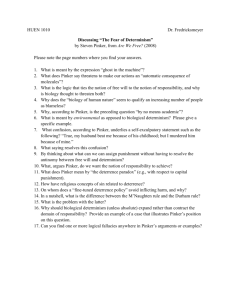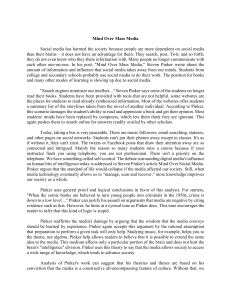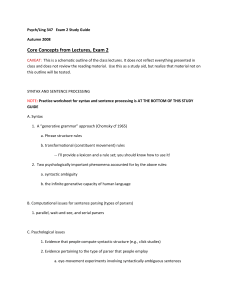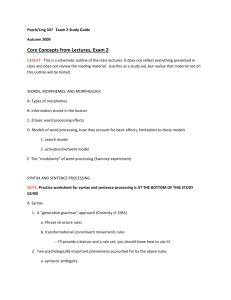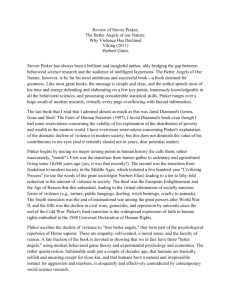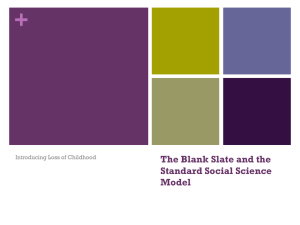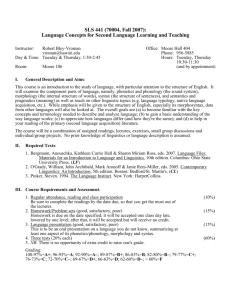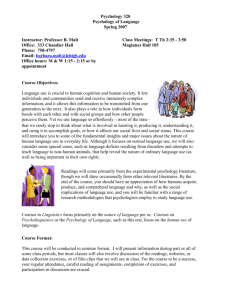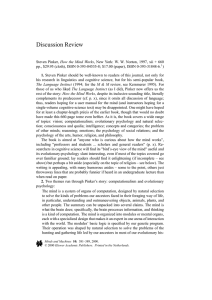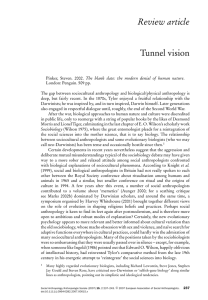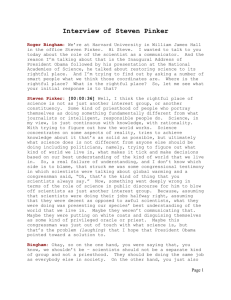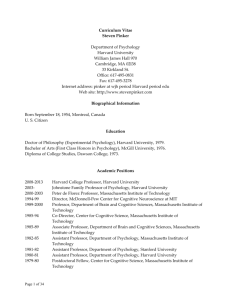IssMeth0114 - Computer Science
advertisement
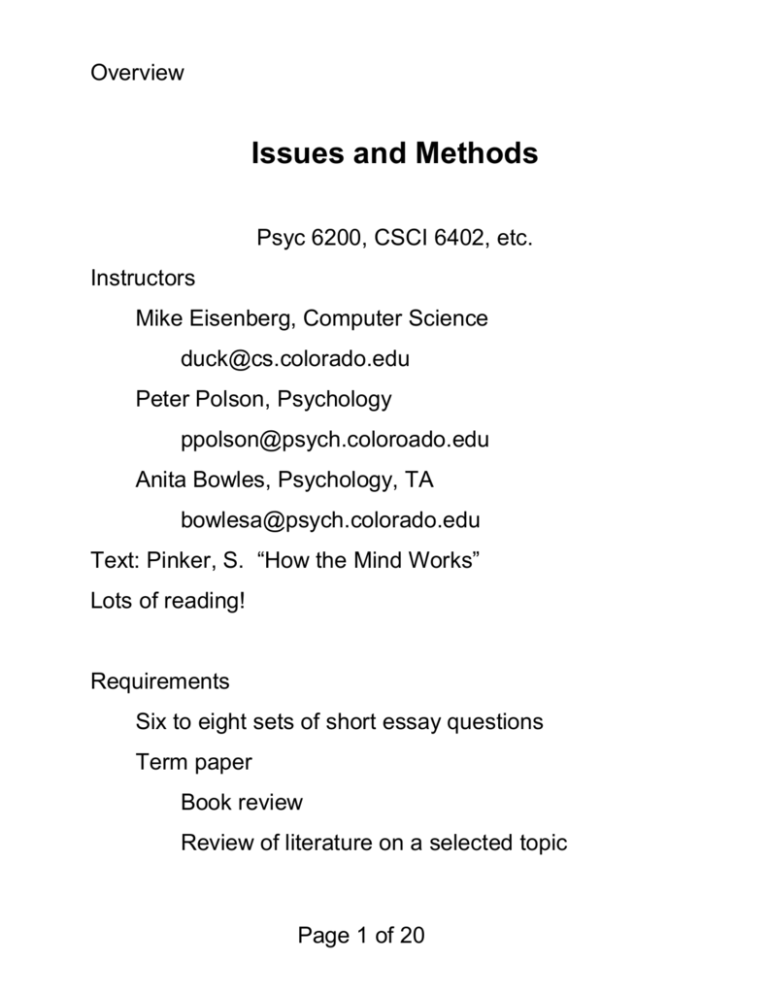
Overview Issues and Methods Psyc 6200, CSCI 6402, etc. Instructors Mike Eisenberg, Computer Science duck@cs.colorado.edu Peter Polson, Psychology ppolson@psych.coloroado.edu Anita Bowles, Psychology, TA bowlesa@psych.colorado.edu Text: Pinker, S. “How the Mind Works” Lots of reading! Requirements Six to eight sets of short essay questions Term paper Book review Review of literature on a selected topic Page 1 of 20 Overview E-mail, the Web, etc Page 2 of 20 Overview Class Discussion List Logon to your e-mail account. Persons using web-based email accounts should take care when sending their subscribe messages. Do NOT send specially-formatted messages, for example, messages with colors, backgrounds, etc. You sign up by sending an e-mail message to listproc@psych.colorado.edu. The program is really stupid. Your message must start on the first line and exactly follow the template below. The body of the message should be: subscribe issues-methods Your name followed by several blank lines For example, a student named John Doe would sign up by sending: subscribe issues-methods John Doe Page 3 of 20 Overview You will get an e-mail message back from the system saying that you have successfully registered. Page 4 of 20 Overview Tentative Outline Dates Topic Pinker 1/15-17 Intro to course and basic themes Ch. 1 1/22-24 The computational model of mind; intro Ch. 2 1/29-31 Problem solving as a model of mind 2/5-7 Ch. 2 Generate and test; Connectionist models; 2/12-14 Rule based models of skill acquisition & expertise 2/19-21 Evolutionary psychology: an introduction Ch. 3 2/26-28 Vision: Computational and neuroscience 3/5-7 Ch. 4 continued 3/12-14 Language: Pinker verses Donald 3/19-21 Infant cognition Ch. 5; 3/26 –3/28 Spring break 4/2-4 Judgment and decision making 4/9-11 Game theoretic approaches Ch. 5 Ch. 6; 4/23-25 Creativity, Scientific Discovery 4/30-5/2 Culture and cognition Page 5 of 20 Ch. 7 Overview Pinker’s ‘How the mind works” Use as a starting place Use each chapter as an introduction to topic(s) Additional reading Introduction to other viewpoints Well written, very controversial Best Introduction To Computation Model of Mind Evolution Evolutionary Psychology “Extreme” Views on Evolution as Contrasted to Gould, etc Language as Contrasted to Bates, Elman etc Page 6 of 20 Overview Where Is Pinker Leading Us? And Do We Want to Follow Him? Chapter 1: Standard Equipment The Robot Challenge Psychology as Reverse Engineering Psychological Correctness Combine the Computation Model of Mind With the Adaptationist Program From Evolutionary Biology and Sociobiology Chapter 2: Thinking Machines The Search for Intelligent Life In the Universe Natural Computation The Defending Champion Replaced By A Machine Connectoplasm Aladdin’s Lamp Page 7 of 20 Overview The Robot Challenge What is Pinker Up To? Supporting the Claim That The Computation Problems Defined by Vision, Motor Control, Common Sense Reasoning (the frame problem), Language Production and Understanding, Etc. Are Very, Very Difficult The Roles of Assumptions and Constraints Performance Requirements Goes On to Conclude That These Problems Are So Hard that They Can Only Be Solved By Highly Specialized Computational Systems A General Propose Computing System CANNOT Solve These Problems Claims about computational complexity!!!! Page 8 of 20 Overview Cognitive Science as Reverse Engineering Given Knowledge of The Functions/Purpose of A System Discover Its Rules of Operation Internal Mechanisms Herbert A. Simon: Sciences of the Artificial Intelligent Systems are Like Artifacts Purposes (Goals) and Behavior Internal Structure Very hard to discover internal mechanisms from knowledge of purposes and behavior Adaptationist Of Views of Cognition and Evolution Pinker Claims That The Mind is A Collection of Mental Organs Our Minds Evolved to Solve the Problems of Our Hunter-Gather Ancestors Page 9 of 20 Overview The Basics of The Computational Model of Mind Problems with Teleological (Goal Oriented) Explanations of Behavior How can mental states (e.g. goals, beliefs) cause physical actions? Computation Model of Mind Solves These Problems Can Build Machines That Follow Rules to Achieve Goals (Solve Problems) Intelligence Defined As Successful Problem Solving All Intelligent Activities Can Be Described as Problem Solving Tasks Problem Solving Can Be Described as Search Through A Space of Possible Solutions Newell and Simon: The Problem Space Hypothesis Intelligent Behavior as The Manipulation of Symbols (Information) Universal Turing Machines The Church-Turing Thesis: Effective Procedures Page 10 of 20 Overview Page 11 of 20 Overview Production Systems Pinker’s Example Starting on Page 71 Is Not Just Any Old Turing Machine. Production System RULES - Describe Knowledge Required to Perform Task - Rules, Productions IF condition THEN action (Condition- Action Pair) IF (Goal and a specific situation) THEN (do actions) WORKING MEMORY - Symbolic Data, Working Memory Elements • Current Goals • Symbolic Representation of External World Page 12 of 20 Overview The Human Information Processing System as a Production System Newell and Simon (1972, pp. 804-5) 1. Capable of expressing arbitrary calculations. 2. Homogeneous representation of control information. 3. Each rule of an independent fragment of behavior. Implications for learning and skill acquisition. 4. Strong stimulus-response flavor; historical implications. 5. Meaningful elements of a complete skill. 6. Working Memory equivalent to Short Term Memory. 7. Rules possible general model for long term memory. 8. Nice balance between goal-direct and stimulus-bound control. 9. Parallel recognition process with serial action generation process Page 13 of 20 Overview Production Systems and Wetware How Do We Build Rule Following Computer System Out of Neurons? Mulloch and Pitts “Neurons” to Logic Gates Logic Gates to a Register Machine A Register Machine Is A Turning Machine But, real neurons are not organized directly into a register machine Connectionism Densely Interconnected Networks and Auto-Associators Content addressable memory “ Graceful degradation” or pattern completion Constraint satisfaction Hard (symbolic) verses soft (real) constraints Tradeoffs Generalization Learning Build a Rule Following Machine Out of Connectionist Parts Page 14 of 20 Overview Arguments About The Computation Properties of Mind Lashley:”The Problem of Serial Order in Behavior Chomsky; “Three Models of Language Newell and Simon: “The Physical Symbol System Hypothesis” Pinker: Five Problems with Connectionism Page 15 of 20 Overview What is the Levels Issue? Newell’s Formulation Computer Architectures The Near Independence of Levels The Knowledge Level Principle of Rationality Goals + Knowledge ==> Behavior Goals, Selection, Implications, Knowledge Marr’s Formulation Computational Theory the goals of the computation Representation and Algorithm representation, nature of transformation, algorithms Hardware Implementation Page 16 of 20 Overview Cognitive Architectures The fixed structure that realizes a symbol system [Knowledge Level ] [Symbol Level] [Functional Architecture (Pylyshyn and Anderson] [Neural-Circuit Level] All the same physical system — A matter of description Fixed can mean changing relatively slowly 109 s Lifetime Development 106 s 103 s Skill acquisition Knowledge acquisition Performance 10 s Internal actions Page 17 of 20 1 s 10-1 s Architecture change? Fixed Overview Anderson (1990) Formulation of the Levels Issue Biological Level NO Help in Dealing with Cognition Implementation Level Focus of Most All Cognitive Research Lacks True Psychological Reality Identifiability Problems Algorithm Level The Physical Symbol System Hypothesis Mapping on to Working Memory States Rational Level Not “Psychologically Real” Not A Higher Level of Abstraction Important Class of Constraints Models of the Environment Goals of The System Adaptive Character of Cognitive Processes Page 18 of 20 Overview Cosmides and Tooby Human minds have a standard collection of reasoning and regulatory circuits that are Functionally specialized Frequently, domain-specific Modules that are analogous to organs Design by evolution Designed to solve problems faced by our huntergatherer ancestors Vision Hearing Motor Control Memory Systems Language Concept Formation and Reasoning Physical causation About plants and animals (natural kinds) About artifacts Page 19 of 20 Overview The Standard Social Science Model is Wrong Page 20 of 20
